Simple Solar LED Lighting and Off-Grid Solar Power Facts
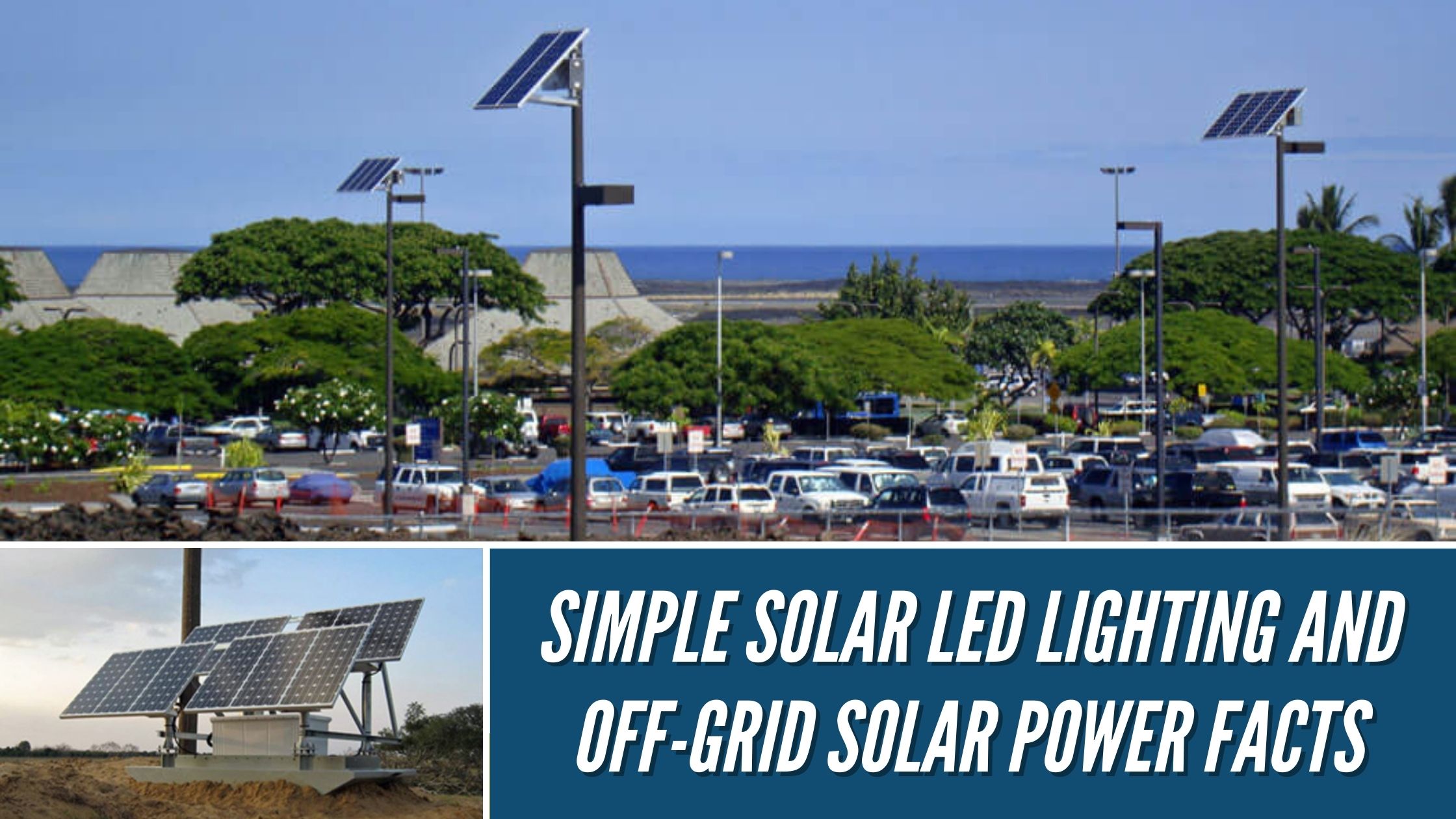
Contents
We wanted to start the New Year off with some basic facts on solar LED lighting and off-grid solar power systems. These facts will explain how the systems operate and provide information on why systems are sized the way they are, how to take into account variables like installation location and operation, and how to make sure you have a reliable system. Mastering these facts will better understand an off-grid solar system used for lighting or power. Let's look at the first fact:
What is a Solar Sun Hour?
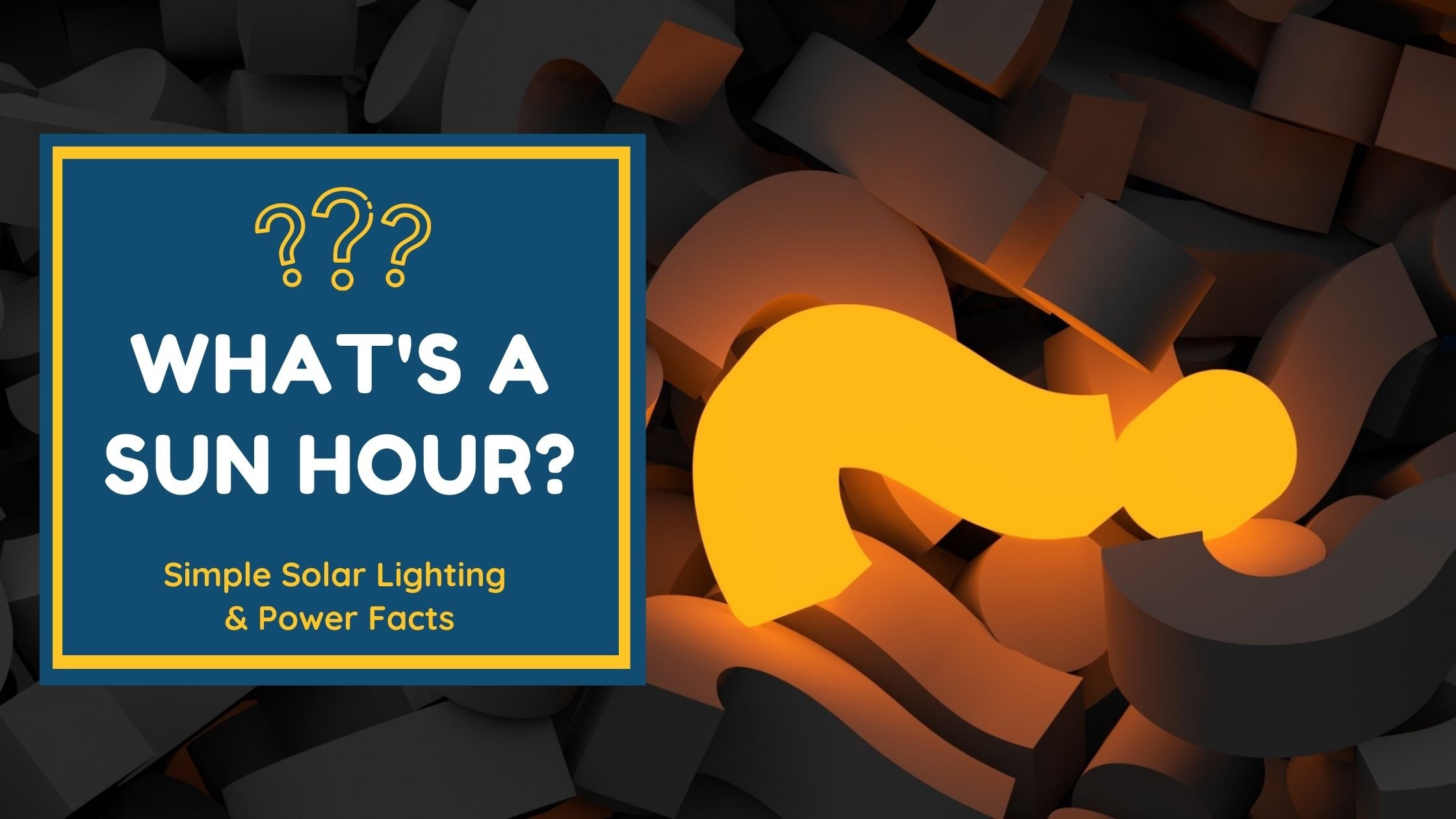
A solar sun hour is the unit of measurement used by solar companies when determining the available sun in a location. Grid-tied systems use annual averages to assess the available sun since the grid can compensate for winter deficits where the summer will produce more than the rest of the year. In addition, the orientation of the solar panels isn't as specific, allowing people to install the solar on their roofs no matter what direction they face.
Off-grid systems need to use the worst-case scenarios to determine how to size a system properly. This information needs to be gathered cautiously and requires the solar to face specifically south. If the panels need to be installed in any other direction, say southeast, this needs to be considered during system sizing and cannot be an afterthought.
The first thought would state that the sun is up for 10 or so hours per day; however, full sun power is used to determine the available sun hours. Therefore, the amount of sun that hits a panel at 10 am is very different than at solar noon and later at 2 pm. The data collected at each site will provide you with the averages of every month, and using December as the worst-case scenario is critical for off-grid solar system sizing.
The amount of sun in a location can vary greatly. For example, some northern areas can only have a couple of solar sun hours available in the winter, whereas more southern sites can have four to five sun hours. Even locations that are relatively close together can have very different sun hours because of variations due to weather patterns, mountains, deserts, and so much more.
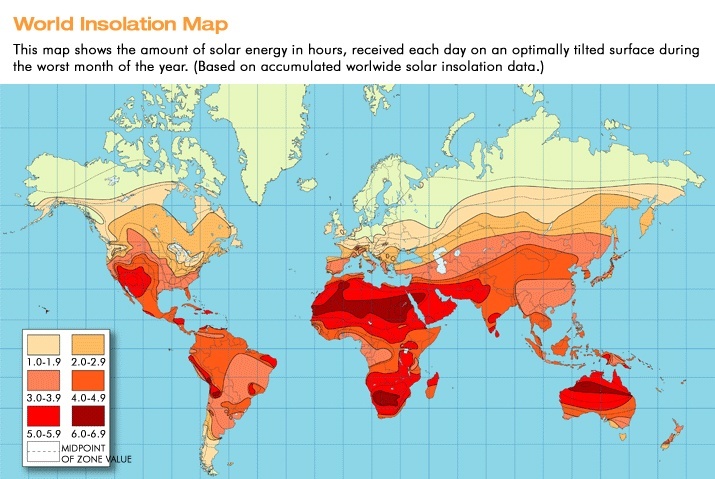
NREL – National Renewable Energy Laboratory determines the sun hours available. Solar contractors and manufacturers can use this and programs such as RETScreen to do the final analysis for determining the available sun. Adjusting factors such as panel tilt and direction to find the optimum solar insolation in a specific area is then added to the calculation. However, most off-grid solar lighting and power systems manufacturers use the standard of 45 degrees of tilt for mounting solar power assemblies.
The information provided is for peak available sun in a specific time (typically shown as a yearly overview calendar with an average). For example, off-grid systems use December as their determining factor when properly sizing up a system; however, sometimes January can have lower available sun and should be used, but January is rare.
The longest night of the year is also used to determine the worst-case operation of the lights or power application. Since the power is primarily used at night, using the worst case will provide a reliable system and can vary from 15 hours or more in northern areas and down to about 13.5 in most southern regions. Most off-the-shelf systems are sized for only 8-10 hours and will not correctly operate in the winter months.
Grid-tied solar power systems still use an average to determine factors for sizing the system. This sizing typically considers the complete load of the system as an average. The load is then divided by the average solar sun hours to determine the amount of power required by the solar to feed the grid and offset the electric usage. For example, you would take the total power used over the course of a year and divide that out by 12, then take the average sun availability at that location and divide out what would be required for solar monthly.
All these variations are used when completing solar LED lighting or off-grid power system, and sun hours play a huge part in the calculation. Understanding the locally available sun in your area will help you determine if the solar system you purchase and use is large enough to operate your system requirements properly. Talk to your solar specialist to ensure that your system is correctly sized and what solar sun hours they use to design your system.
Solar Outside the Sunbelt
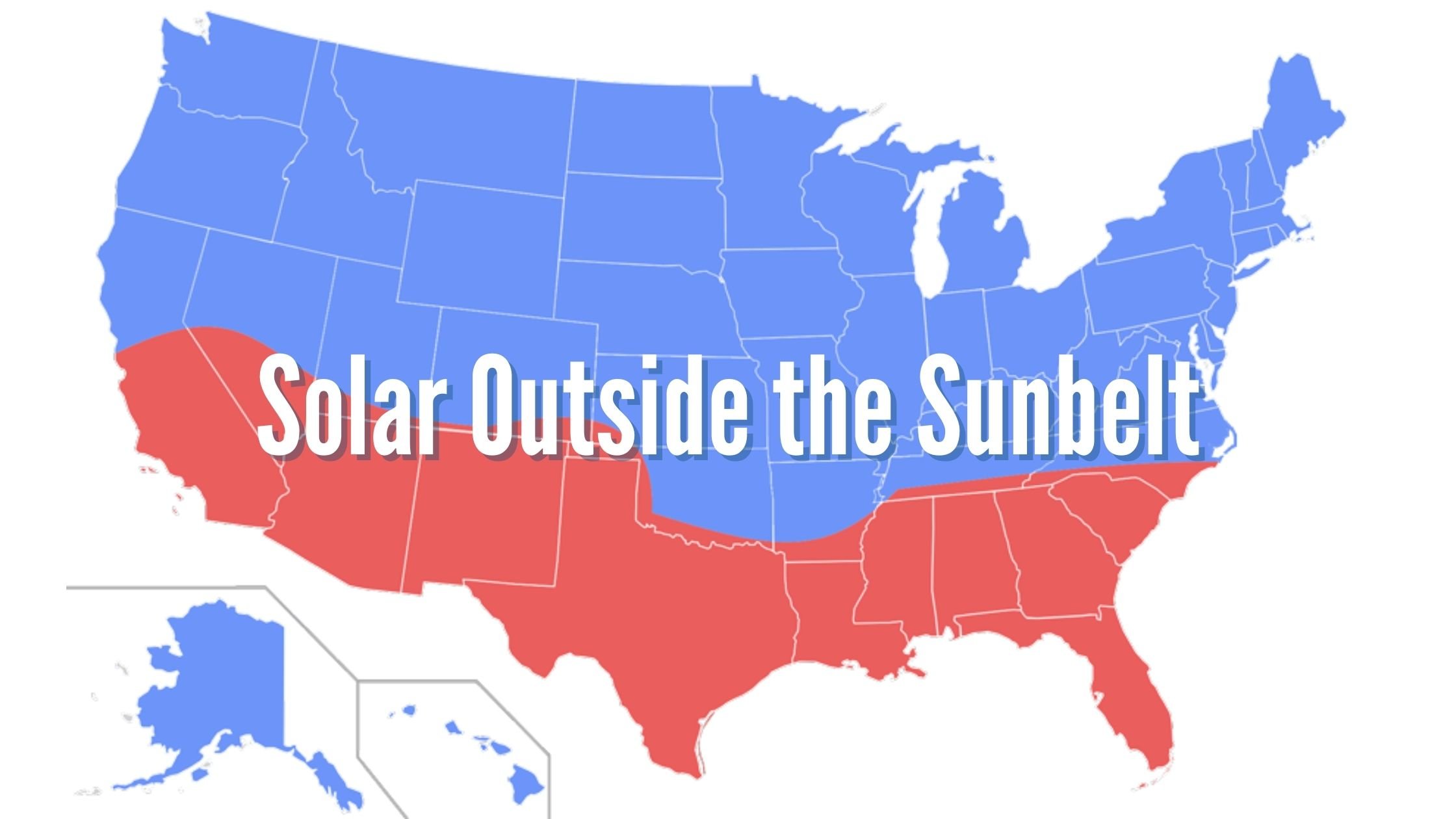
Okay, next we look at solar outside the sunbelt. Solar power assemblies are installed worldwide for lighting and power configurations. Solar sized properly can be installed in almost any location. Of course, solar installations inside the sunbelt are more efficient and require much less power since there is more available sun and shorter nights, but that does not mean that solar cannot be used outside the sunbelt.
Solar lighting and power systems should always be sized accordingly to ensure proper operation inside and outside the sunbelt. Inside the sunbelt, more power can be achieved using the same solar power assembly northern areas need for a much lower power draw.
For example, in the sunbelt, a 50 Watt power draw would only need a single 200 Watt solar to give or take to operate all night, whereas, in the northern areas, this same system would be twice that size. This is because the nights are longer, and the sun availability is much less. In some cases, 50 Watts may not even be achievable for an all-night operation, requiring some other setup to be used.
If more power is required, alternative methods of operation are investigated, such as adaptive lighting, where the systems operate a full for a set period and then reduce when the area is no longer active. Another great way to reduce power is to operate using split time or just dusk activated for a set number of hours.
Motion detectors can also be used but watch out. Many importers use motion-sensing technology to undercut the solar and battery, making the systems way undersized and prone to failures. In many cases, we have seen a system labeled as "all night," but it turns out that the light only operates an hour or two at best. These shady techniques are what give solar a bad reputation in many cases.
Solar operation profiles are a great way to narrow down how the lights operate in different locations. Solar lighting systems have many ways to adapt to each project, and power applications can operate up to 24/7/365 depending on the device's needs. One of the best things about solar is the ability to adapt to the project and location, even in places far outside the sunbelt.
How to size for Worst Case
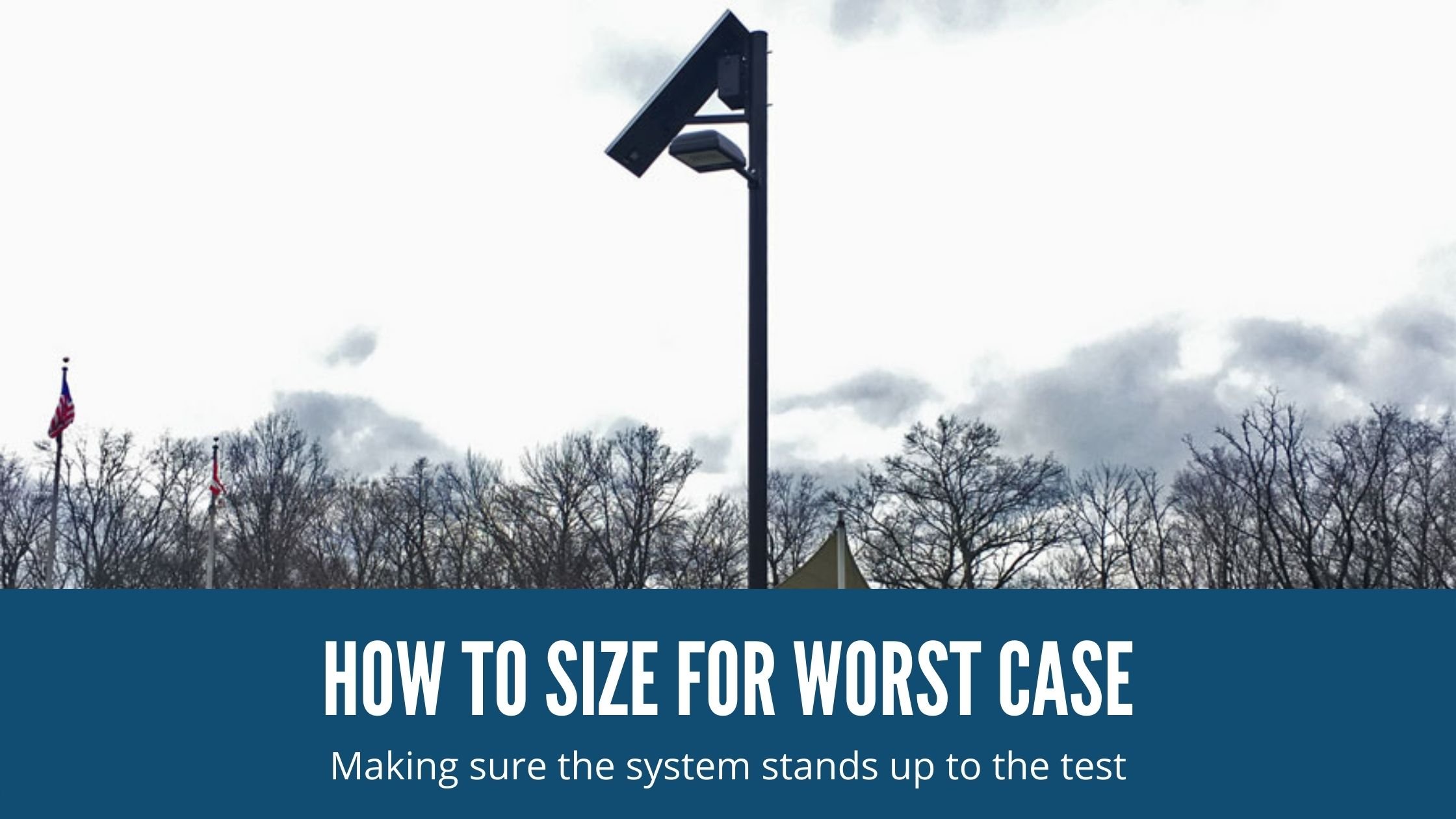
Sizing up a solar lighting or power system can be a difficult task. There are two major ways for getting all the calculations correct for two completely different types of systems; grid-tied and off-grid. Understanding the way your system will operate will make sure you get the correct information to size the system properly.
Grid-Tied System Sizing
Grid-tied solar lighting and power systems use averages to size the system. The average sun hours are used to calculate the available sun for your area and the systems are sized according to that. They also use the average length of night and the average power consumption.
For example, if you have 100 Watts operating 24/7/365, and you have an average of 4.5 sun hours, you would need around 750 Watts of solar power. During times when the sun is stronger and you have more available sun, this would feed the grid more than what is being used. During times when the sun isn’t as strong, the system would pull energy from the grid to offset what the panels couldn’t do.
This is a NET Zero application for grid-tied systems and is how most homes and buildings that are still grid-tied are designed. If less solar is installed, the system offsets only a percentage of the total electrical usage; however, in either situation, the systems shouldn’t fail since grid power still exists.
Off-Grid System Sizing
Off-grid system sizing is completely different than grid-tied. Worst-case scenarios are used to determine the sizing of the system, which typically includes the longest night of the year as the operation time and the lowest amount of sun available, usually December sun hours (insolation). Other factors such as low temperatures and humidity conditions are also taken into account with this size system.
Worst case sun hours vary from region to region. Here in most of Florida, we have over 4 hours of sun in December. Areas like Arizona have upwards of 5.25 sun hours. Maine has 2.5-3 sun hours and most of Washington State has less than 2 sun hours. Overcast weather affects this greatly and should also be remembered during the sizing process.
The longest night is also a factor for dusk to dawn operation. Florida has 13 hour nights, but Maine has 14.75 hour nights. If the systems can have different control options, for example using a split time operation turning off in the middle of the night, this can greatly impact the system sizing and still allow for good system design.
Since off-grid systems are just that, off-grid, battery storage systems are used as a backup. Autonomy, or backup power, is provided for a minimum of five days in properly sized systems, longer in colder regions since the depth of discharge on the batteries is greater in these climates. This means, if the area of installation drops to zero degrees or below Celsius, or 32 degrees or below Fahrenheit, you can lose up to 20% of the battery’s capacity. Once you hit -20°C or -4°F, you are down to 50% capacity. Having only a three-day backup built into the system will cause the system to fail quickly.
Taking into account all these different factors when sizing an off-grid system and looking at the worst-case scenario for conditions, will ensure that the system is properly manufactured to operate during the worst time, and therefore, flawlessly the rest of the year. This is essential when there is no backup grid power available to a system.
How the Lights Turn On & Off?
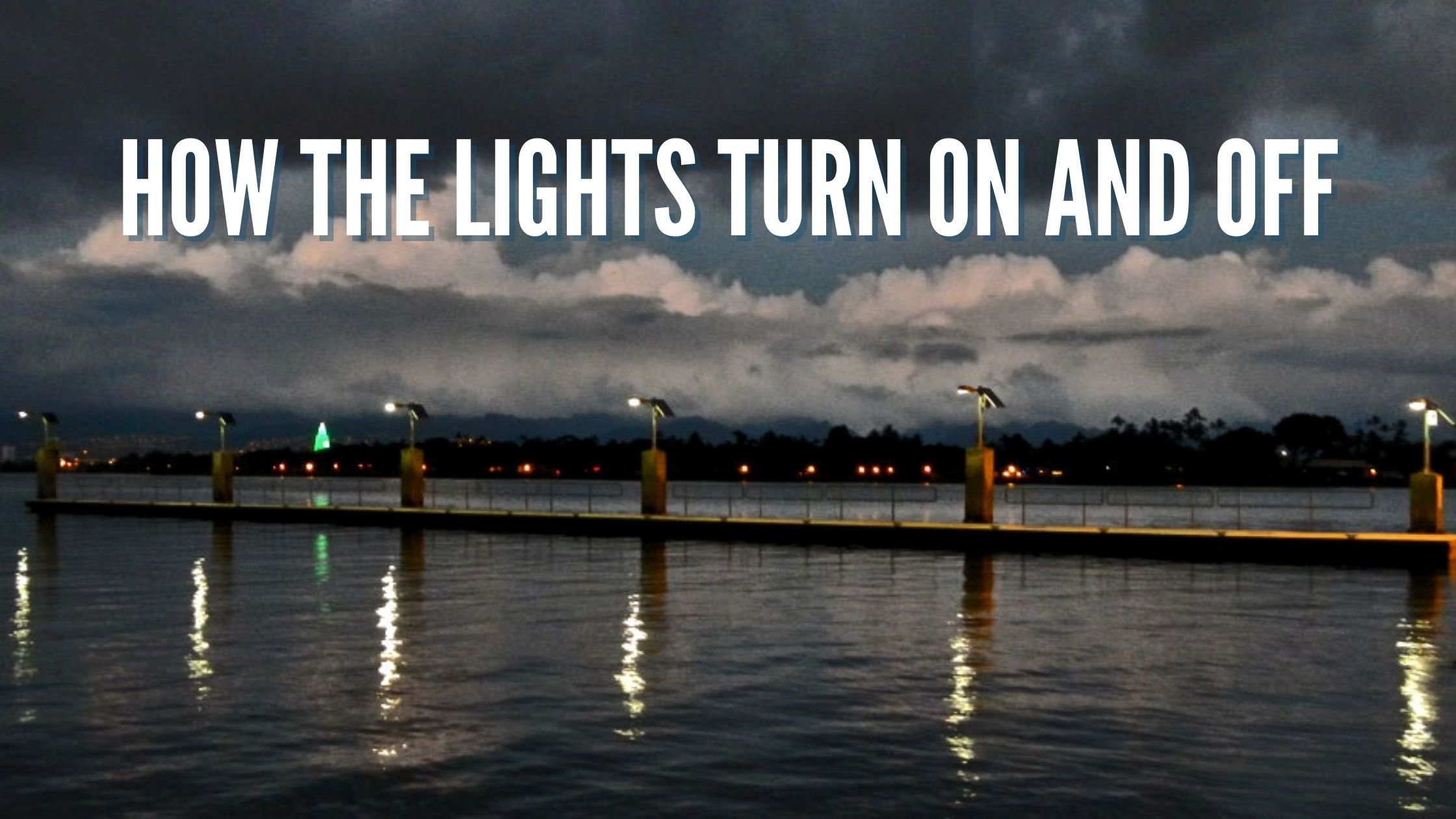
The basic controls of a solar light system are quite simple for the most part. The solar lights turn on at dusk and off at dawn if using dusk to dawn configuration. They can also turn on at dusk and operate according to the preset configurations for other setups. We wanted to cover exactly how the solar lights understand when dusk and dawn are by breaking it down.
The solar panel generates power during the day. The control electronics know when the solar panel generates power and feeds it to the battery assembly. As the sun sets, the panel generates less and less power, and once a specified threshold is met, predetermined by the manufacturer, the controller will switch, and the lights will turn on. It is that simple
At dawn, the panel generates power again as the sun rises. The power generation triggers the control electronics to make another switch to turn the light off and start feeding the power being generated into the battery assembly again. This process is repeated daily.
If an adaptive lighting control is being used, or a split time operation, the system is set at the factory for dusk for x number of hours after dusk and a number of hours before dawn operation, with either a reduced or off operation in between. Once the system is installed, it understands when dusk happens and then guesses on dawn; however, it learns quickly to actual dawn time. To have the system working perfectly only takes a night or two of the controls learning the exact times of dawn to know when the system should work.
Split time and adaptive lighting operation schedules are becoming more popular since when there is little to no activity, typically after midnight and before 5 am; the lights can either shut down or reduce, allowing for smaller solar power assemblies or more wattage during the full illumination periods.
The control electronics control the lights to whatever preset operation a specific project requires. There is no longer a requirement for a photocell on the solar light fixtures, which typically needs to be changed out due to failures since the solar panel acts as the photocell with solar lighting systems. This setup reduces failures from having additional electronics that can fail and cuts maintenance costs.
Power systems work very similarly and use the same control electronics, even if the system operates 24/7. The same controller used for the lights can be used in an off-grid solar power system and regulates the power produced, charging the batteries, discharging at night when no power is being generated, and again the next day. The simplicity of the controls makes the system more reliable than other forms of controlling the systems.
How Shade Affects Solar?
How does shade affect solar? This one should be a simple answer, right? Yes and no. The shade will render solar inoperable; however, if there are known shading concerns, the systems can be oversized to take advantage of times when it is not shaded. But the general consensus is to trim trees, place the solar in the sunniest location possible, and keep it out of the shade from 9 am to 4 pm year-round.
We have touched on this subject in the past with our post Location Location Location: Why Shading is Bad for Solar Systems. In this post, we explain how solar can be remotely mounted in a non-shaded area to ensure the power assembly will operate correctly or how trimming trees is a great way to eliminate the problem altogether. Installing the system on a roof can also ensure that the solar doesn't become a shade when tall buildings are in the area.
But let's take this a step further. I found a video that shows real-time what shading can do to a solar panel:
Crazy, right? Just a little bit of shade already affects the solar panel and drops power production. It doesn't require the panel to be shaded entirely to render it inoperable. This drop in power is because solar arrays are divided into strings. Shade one section of the panel and the whole string will stop working. Shade across all the strings and the panel will completely stop working.
Increasing the panel size can compensate for this a little, but it isn't the best solution. Since there is no telling how much the shade is going to affect the panels without field testing, it is always better to make sure your solar is not shaded at all, facing south, and sitting around a 45° angle. This is the best installation method for almost all applications, especially off-grid installations.
If you follow the above and keep your solar panels away from shade, you will ensure that your solar produces enough power to charge the batteries completely during the day. In addition, this will ensure that your solar lighting and power systems are able to operate at night as required.
How to Analyze Costs?
Solar lighting systems are designed to be installed in cases where the grid power is cost-prohibitive to bring in, where underground wiring has deteriorated or been broken, or be designed into a new project early on. Solar lighting systems are not typically used as a green alternative when replacing old lighting technology as a cost feasible solution.
Solar lighting systems that are commercially manufactured and designed properly can be expensive as you are paying for the power up front, not over time like traditional grid-powered lights. Instead of just paying for a light fixture, and then the energy to operate that fixture over time, you are paying for the solar to generate the energy and the battery assembly to store the energy produced during the day for use at night.
The solar power assembly needs to be large enough for your installation to power the required light for the designated time frame required. Grid-tied lights also don’t take into consideration the wattage that is installed or the energy costs over time. Read more about solar sizing requirements.
This is why off-grid solar lighting systems are great for installations where the grid power is cost-prohibitive or in cases where the underground grid lines have gone bad. There is no trenching involved with installing an off-grid solar system; the solar provides the power and all wiring is located at the light source or nearby with applications such as signs.
For example, if you have a large parking lot where the underground wiring has gone bad, either due to time or someone cutting the line, trenching the parking lot, repairing the lines, and repairing the pavement can be a costly project. Off-grid solar lights may be the best option since the poles are just placed where they are needed. This will lower the project cost to repair all the wiring and decrease the installation time.
Off-grid solar power systems work basically the same way. If the power is difficult to bring in, or the wiring has become damaged, solar is a great alternative to traditional grid power.
If off-grid solar lighting or power is being requested, a cost analysis of the systems can be performed to show the ROI and / or savings of the solar vs the grid-powered system. This can be requested from the manufacturer. In order to do this analysis, detailed information about the grid power costs for the area as well as project costs will need to be provided.
How long will a System Last?
Commercial solar lighting and solar power systems have a great life span if sized appropriately. Each component has a different life span, but as a system in whole, the solar light should last 30 or more years with proper maintenance. Let’s go over each component and dissect how the systems should operate over the 30+ years.
Solar Batteries
There are two types of batteries used in solar lighting and off-grid power systems; GEL cell and lithium-ion. GEL batteries are the most common with lithium-ion starting to hit the market. There are pros and cons to each type of battery; however, we will cover the life span of GEL batteries here since this type of battery is proven in the field where lithium-Ion batteries are still new to the game.
GEL batteries should last anywhere from five to seven years in the field when properly sized. The depth of discharge in cold weather must be taken into consideration to get the number of cycles to stay in this range. Since the cold degrades the batteries, additional autonomy should be included so that the systems never use more than 20% of the battery capacity per night and have the solar capacity to bring the batteries back to full.
Control Electronics
The control electronics are the brains of the solar power and lighting system and control all aspects of the functionality. The control electronics tell the batteries when the solar is producing power and when to operate the light or electronic device. This brain should last 15 years or more and do not require any maintenance to keep their functions.
New controls are constantly being developed, and like any electronic device, advances in technologies are constantly changing. However, most basic functions have been the same over the last decade or more.
LEDs and Fixtures
LEDs are advancing as fast as any other electronic device. A few years ago, you could expect an LED light to operate 50k hours, but today, you will be able to get 100k hours or more life. That is 20+ years for dusk to dawn applications.
Fixture housings have improved over the years as well. With improvements in the powder coating and painting methods as well as materials, the fixtures themselves should last as long as the LEDs inside them.
Solar Panels
Solar still has the longest life span of any component. Solar panels are typically warrantied for 20-25 years and have a life span of over 30 years. Since there is no moving parts or anything that would be changed out, you can just install the solar panels and forget them, but make sure not to shade them.
Mounts and Hardware
Most companies today use aluminum for mounts and stainless steel for hardware. This allows the systems to hold up in coastal and other harsh areas without rusting or deteriorating away. If standard steel is being used, even if powder coated, the mounts and hardware will not stand up to the weather. If aluminum and stainless steel are used, they should last 30 years or more.
As you can see, commercial-grade solar lighting and power systems should last quite some time with little to no maintenance. Taking these factors into account with the initial purchase will make sure you are getting a system that will stand up to the test of time and provide a good return on investment. Check your manufacturer’s warranties and business history to make sure you are working with a reputable company that can stand behind their product.
That's about all we have for you. Next, we went over what a sun hour is, how solar works outside the sunbelt, how they turn on and off, and how shade can affect a solar system. Having a basic understanding of the various topics around solar can ensure you get a system that will work in your location. Also, asking your specifier questions and seeing how transparent they are when answering will tell you how skilled they are in system design and ensure you aren't getting a system that won't let you down.

